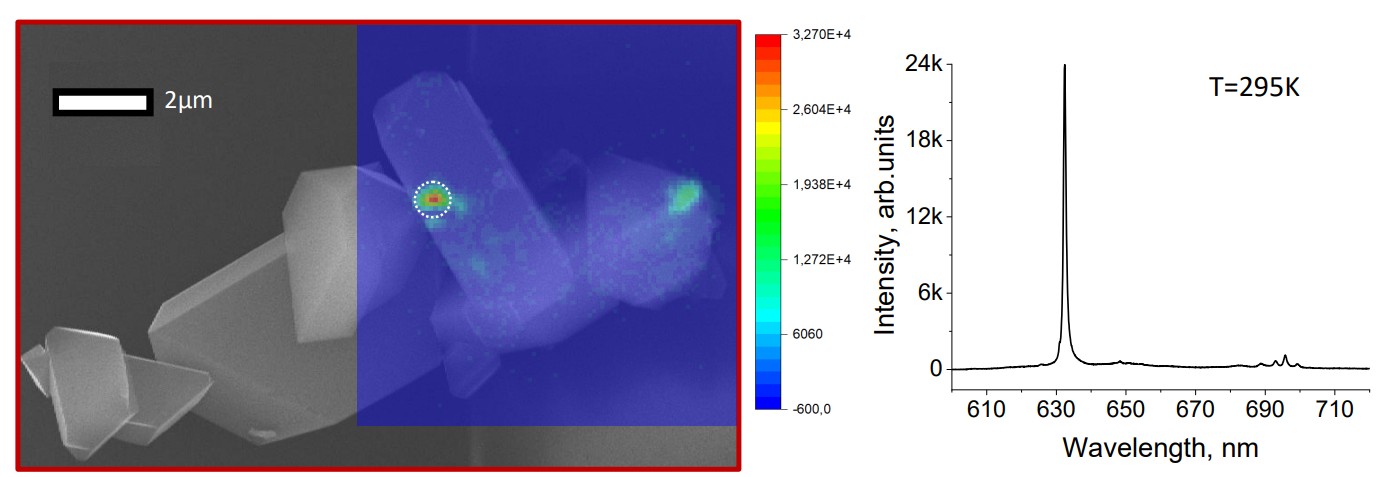
Image. The black-and-white picture shows a microdiamond crystal as seen with a scanning electron microscope. The overlaid blue square with scattered spots of color is a fluorescence microscopy image highlighting the new color centers discovered by the authors of the study. These are defects that re-emit previously absorbed light in a narrow spectral range. Namely, as seen in the graph to the right, most of the emission occurs at a wavelength of about 630 nanometers. This peak has the merit of being clearly discernible, and it shifts depending on ambient temperature, allowing the diamond to be used as a remote temperature sensor. Credit: Arthur Neliubov/Skoltech
Scientists from Skoltech, Moscow Pedagogical State University, and other research centers have discovered a new class of defects in diamond that may be of use for quantum information processing and precise and remote temperature measurements within very small objects, such as living cells. The findings are reported in a letter published in Physical Review B.
Color centers are an umbrella term for defects of various nature in a transparent crystal, usually diamond. Typically, a color center is a foreign atom, such as nitrogen, incorporated into the crystal lattice of diamond, with one or more nearby carbon atoms missing.
What gives color centers their name are their optical properties. While diamond itself is transparent to visible light, color centers are spots in it that have the technologically appealing capacity to absorb light and effectively re-emit it in a rather narrow spectral band — that is, with a very specific color (wavelength). Importantly, color centers can effectively emit single photons. There are several potential applications where this narrow-band single-photon emission comes in handy.
Single photons are building blocks for quantum optics and quantum information applications. For example, such photons are useful for the ultimate data security technology — quantum encryption. It enables secure information transmission between two parties and involves an exchange of encrypted messages and keys to them. The key needs to be transferred over a secure channel, and some quantum key distribution protocols require an effective source of single indistinguishable photons. It means that the parameters of the emitted photons, such as polarization and wavelength, must coincide with a high degree of accuracy.
Another exciting property of photon emission from color centers is that the wavelength of the emitted light is sensitive to ambient temperature. This means that photons produced by these defects carry information about the temperature of the environment where the diamond is. Given the fact that scientists can create nanodiamonds with embedded color centers, it is possible to create very small thermometers with a high spatial and temperature resolution. According to the researchers, such temperature sensing would work well in biological applications. In other studies, nanodiamonds have already been introduced into cells to investigate internal temperature variations.
“Color centers in diamond have been known and studied for about 40 years. The new variety that we discovered has superior properties as far as potential technological applications go. Namely, the spectral range of emission from our centers is almost 10 times narrower compared with all previously known color centers. The narrow-band emission and the high brightness would make for more sensitive thermometers,” the lead author of the study, Skoltech PhD student Arthur Neliubov, commented.
He added that a further interesting property of the new color centers is narrow-band excitation: They not only emit light in a narrow spectral band, but absorb it selectively as well. In a way, every color center even of the same class is a little different, and there are applications where this could be exploited to elicit response from them in a very targeted fashion. An example would be an analytical technique used in biology known as multicolor imaging, where the “defective” microdiamonds could come in handy as nontoxic, nonradioactive, and highly unique biomarkers.
The new color centers are so far identified by a set of features on the fluorescence spectra — graphs characterizing the light emitted by the diamond sample. However, the actual nature of these defect centers is yet unknown. The researchers have a couple of guesses but say more research is needed.
“We did not introduce any defects on purpose, and yet the color centers reported in our study presented themselves with only slight variations in pure synthetic microdiamonds from three different batches,” Neliubov said. “The microdiamonds were produced via high-pressure, high-temperature synthesis with the use of an organic compound called adamantane as precursor. It remains to be determined whether these color centers also come up in natural diamonds and in synthetic ones produced by other methods.”
The team’s other plans for future research into the newly discovered color centers include investigating their optical properties at very low temperatures. In fact, this might betray what physical defect in the crystal lattice underlies the color center.
According to the team, the discovery has been made possible due to the development of a novel method. The researchers managed to combine two different experimental techniques: scanning electron microscopy and fluorescence spectroscopy. “This enabled us to label the most interesting microdiamonds exhibiting color centers and conduct multiple series of experiments on the same diamonds using different equipment. Also, the high sensitivity of the experimental setup allowed us to zoom in the analysis to the point where we were looking at individual color centers. That’s how we could characterize this new class of emitters,” Neliubov explained.
Besides scientists from the Skolkovo Institute of Science and Technology and Moscow Pedagogical State University, the study reported in this story featured researchers from three institutions that are part of the Russian Academy of Sciences: the Institute for Spectroscopy, the Institute for High Pressure Physics, and Lebedev Physical Institute.
Contact information:
Skoltech Communications
+7 (495) 280 14 81
